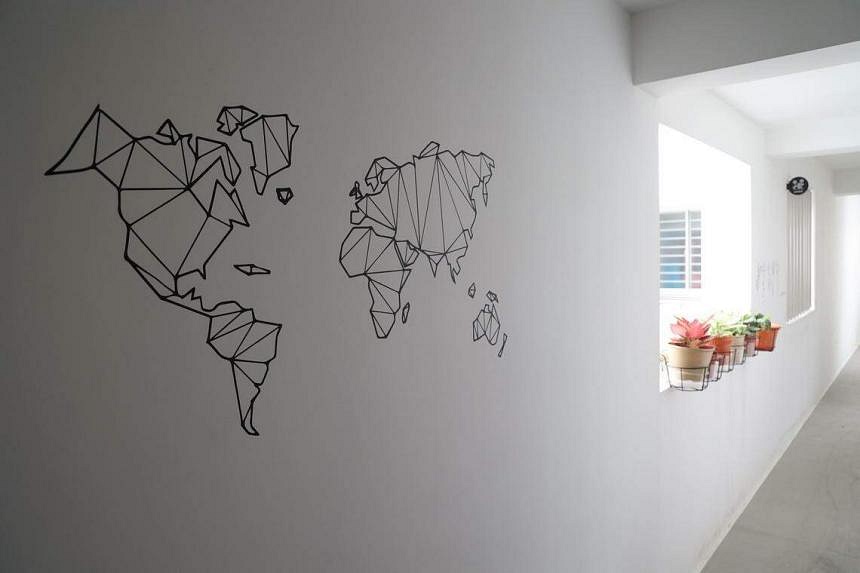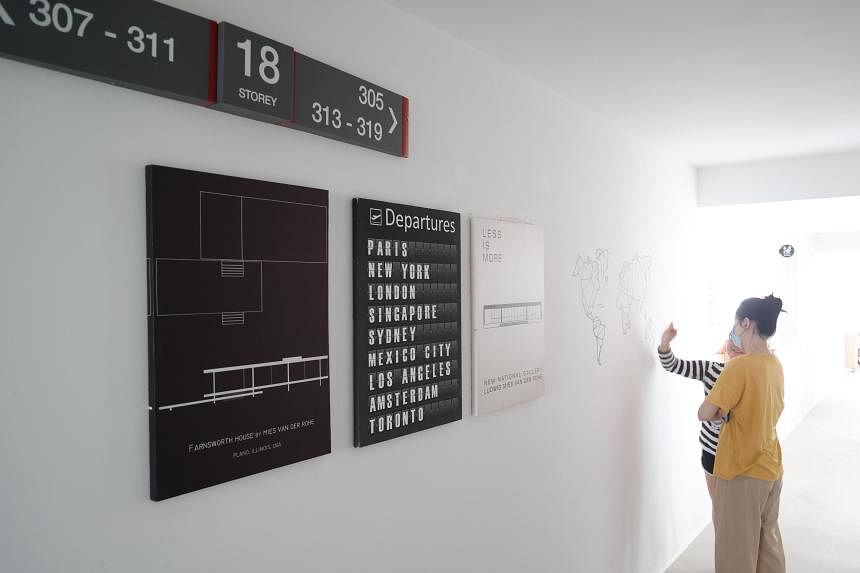SINGAPORE - What is pleasing to the eye to one may not be the same to others.
That, along with safety during emergencies and clutter in common areas, is a thing to consider when it comes to decorating these spaces in HDB estates, experts and the authorities told The Straits Times.
The issue arose after reports in January that a Senja Heights resident was asked by her town council to remove decorations she had put up along her Housing Board flat’s corridor.
The resident, who wanted to be known only as Ms San, decorated the common space with three canvases attached to wooden frames that weighed about 200g, and temporary stickers, or decals. The decorations cover the walls of about two units and can be removed easily without causing damage, she added.
Ms San, who works in business development and is in her 30s, said the decorations had been up for about six months when she received a notice from Holland-Bukit Panjang Town Council (HBPTC) on Dec 21, 2023, requesting that she remove them.
Town council representatives visited her flat that week, reiterating that the decorations had to be removed as they could be hazardous should they fall.
Ms San told ST that she was confused by the town council’s request as she had taken extra care to ensure her decorations did not violate any laws, pose danger to others, or damage property.
Referencing residents from other neighbourhoods whose social media posts on decorating their corridors with extensive festive decorations or similar framed artwork had gone viral, she questioned what regulations were in place regarding resident-initiated decor and what materials were acceptable.
“Why do some town councils allow this and why do some not allow it?” she asked.
She added that she has no qualms about removing the fixtures if needed, but hopes for a more thorough explanation from the town council first.
In response to queries by ST, HBPTC said that it adopts a lighter approach to temporary decorations in common spaces, especially during festive seasons such as Chinese New Year, Hari Raya, Deepavali and Christmas.
However, it would be more concerning if the fixtures were of a more permanent nature as they could damage and stain the infrastructure of shared spaces, it added.
Such fixtures could also hinder cleaning and maintenance works, said HPBTC.
ST approached 17 town councils on resident-initiated decorations in common spaces; East Coast Town Council said it would not be responding at this time, while ST did not hear back from the others.
Ms San also approached her MP Edward Chia on the matter. She said he empathised with her, but cautioned her that not all her neighbours may share the same aesthetic preferences.

This view was shared by others whom ST spoke to.
Nominated MP Syed Harun Alhabsyi, who spoke on boosting social cohesion in common spaces in residential estates in Parliament on Jan 9, said that such efforts to decorate common spaces may be a way in which people try to make spaces more personal.
But he added that corridors tend to be more private to residents and could evoke greater sensitivity from home owners, while void decks and other common areas in the neighbourhood may be more amenable to wider public use and have latitude for some creativity.
Putting up fixtures in public areas and narrow spaces like corridors without permission may also clutter or create confusion during emergencies if they distract or obscure signs that are meant for safety, he said.
He added that this should be distinguished from short-term, seasonal celebrations of ethnic and religious importance meant to spread momentary festive cheer as they help foster greater understanding across faiths and different communities.
Associate Professor Laavanya Kathiravelu of Nanyang Technological University’s School of Social Sciences agreed that not everyone may view decorative ornaments the same way, but cautioned that not allowing residents to express themselves in these spaces may lead to people feeling less ownership or guardianship over them.
“This may mean that residents take less care of these spaces through their own initiatives, like through removing litter or making sure that faulty lights and equipment in these spaces are reported to the relevant authorities,” she said.
Prof Laavanya added that residents coming together to collectively decorate or beautify a shared space could lead to positive outcomes for social cohesion, but requires residents arriving at a consensus beforehand.
She noted that in many other countries with a “strong culture” of neighbourhoods coming together to organise events, “these things often happen organically, without a need for the involvement of designated residents’ committees or town councils”.
As for Ms San, she has not given up hope of keeping her decorations up. She had submitted an appeal, with her MP’s help, to the town council on Jan 1, along with a letter of support signed by all the residents on her floor.
She is slated to meet her MP on Jan 25 to follow up on the matter.
Ms San added that the decorated wall is still a work in progress and suggested to the town council that it be turned into a communal project for residents to creatively collaborate on together.
A resident on the floor told Chinese news outlet Shin Min Daily News that she was happy to see someone take the initiative to decorate the common space and felt it beautified the corridor.
The resident lives in the unit directly facing the decorations and said she hopes the town council will let them remain.
Ms San said: “Even though we are living in HDB flats, it doesn’t mean that it should stop us from exercising some creativity to liven up our environment.”


